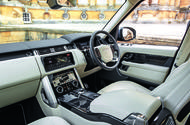The perceived quality is high, but the actual quality? Time will tell
Clarifying the difference between ‘perceived’ and ‘actual’ is essential when discussing the fit and finish of an interior
Define ‘quality’. I got asked it once, during a lecture about materials or production or something. I forget exactly.
But I do remember the lecturer and his love for the way metal coat hangers were made. It was his favourite topic: he was fascinated by this long piece of wire, complexly bent to make a cheap, reliable and efficient product. He thought it was one of the world’s greatest inventions.
And I think that, in relation to the quality question, its relevance was: how would a basic wire coat hanger fare if you asked people whether it was of good quality?
Answer: it wouldn’t do well. Wire coat hangers are cheap. You can buy 50 of them for £7. They’re very basic and there are far more luxurious examples of coat hangers that do a better job at hanging. You can get wooden ones, or padded ones, or ones with little clips on. Go to pretentious hotels and they’re so worried about you nicking them that they tie them to clothes rails. So they must be good quality, no? Good quality is nice, bad quality is basic: that’s what we all thought.
Ah. Not so, said my lecturer. Because in production, that’s not what quality means. When you have quality control in a factory, it’s there to ensure they build the same thing to the same standard, every time. That’s it. Is it to specification? Then it passes.

The quality control at the wire coat hanger factory doesn’t reject every wire coat hanger because it doesn’t smell of lavender or have a yellow bow tied around it. Well, I assume it doesn’t. I imagine it passes the vast majority of wire coat hangers as fit for purpose because they’re built like they should be.
To give said lecturer his due, they are fantastically durable. Unlike plastic or wooden or padded coat hangers, I haven’t had to throw a wire coat hanger away since turning one into a makeshift car aerial two decades ago.
Which brings me to car interiors and the phrase, which some of my colleagues have taken a dislike to, ‘perceived quality’.
The ‘perceived’ bit is the important bit. Some people feel using it pulls punches, that it’s weaselly, that we should mean what we say. Me, I try to use something pithier, but use of ‘perceived’ isn’t a cop out, it’s an important clarification.
The thing about assessing a car interior is that ‘it feels well screwed together’ is very different from ‘it is well screwed together’. One says it has high perceived quality, the other suggests it has high actual quality, and short of disassembling a car and/ or having a huge consumer survey once the car’s in general use, you can only know one of those is true.
Some very expensive cars, which might feel of high quality, routinely finish bottom of customer satisfaction surveys. They feel great, but they’re actually rubbish to own and, ultimately, these are surveys of quality.
If I wrote that a car ‘has a good quality interior’, it would be an explicit endorsement of not just how a car feels, but how it is made. And then when it fell apart after three years, you’d call me a lying toad. And I’d rather you didn’t do that, so I won’t take the chance. I will, though, bet the wire coat hanger is the highest-quality thing you’ll own.
Read more
Smooth sailing: How to build the most comfortable car
The strangest car interiors ever made
Back to the future: revisiting the Audi A2
Source: Autocar
